If you run an online business, marketing plays a huge role in determining how successful you are.
Take blogging, for example. Marketers that prioritize blog content are 13x more likely to see a greater ROI. 42% of B2B marketers go as far as to say that blogging is the linchpin of their marketing strategy.
That’s just one type of marketing, though. If you want your business to thrive, you’ll probably need to focus on several angles.
Consider email — 91% of shoppers say they want businesses to communicate with them mostly via email. However, up to 15% of businesses don’t review their email metrics at all — they’re literally flying blind.
The deeper you get into the world of marketing, the more processes you’ll need to shuffle. That means you’ll have less time to spend on other aspects of your business, such as improving your products or services, managing your team, providing client support, and more.
That’s where marketing automation is needed to increase efficiency and lower costs.
Why Your Business Can Benefit from Using Marketing Automation Tools
Let’s say your business does most of its marketing outreach through email. Your website brings in leads, you sign them up using a form, and then you use email to drive sales.
There are a lot of ways to do that. For example, you might send new leads a welcome email series that tells them more about the products you offer, how they work, and what they can do for them and then hit them with an offer at the end.
That series might look something like this:
- Email #1: Welcome email that thanks your new customer for signing up and explains why they should be on the lookout for more messages.
- Email #2: An introduction to the products or services you offer and what your Unique Value Proposition (UVP) is.
- Email #3: Discussion of the ways they can benefit from your offers.
- Email #4: A special offer with a CTA, designed to get conversions.
That’s a very simplified example, of course, but it serves to illustrate a point. To make that series possible, you need to (a) create four individual emails, (b) set up a trigger that starts the chain, (c) schedule each email to arrive separately, and (d) keep track of metrics related to your campaign.
All that, and you’re not even getting into more complex marketing territory, such as personalization, split testing, and more.
Marketing can end up taking over the rest of your business if you’re not careful. The entire point of automation tools is that you can configure them to take care of repetitive tasks so you can reclaim your time.
Digital marketing is highly complex, and if you’re going to entrust your business to an online platform, you need to be very picky.
What Features to Look for in Marketing Automation Tools
It shouldn’t come as a surprise that there’s no shortage of marketing automation tools to pick from. That makes your job a little harder because if you’re green when it comes to digital marketing, it can be difficult to know what features you should be looking for.
The most important thing to consider is what type(s) of marketing you want to focus more on. Content, social media, and email marketing require very different sets of tools. Ideally, you’ll find a platform that enables you to tackle all of them together so you don’t have to pay for multiple services.
With that in mind, here’s what you need to be on the lookout for:
- A high degree of customizability. You want to be able to configure every single marketing automation your business is going to rely on. Some platforms rely too heavily on pre-built automatizations, which makes them a poor option.
- Multiple sets of plans. Marketing automation tools tend to be very expensive (and we’ll talk more about this later). That means that there aren’t a lot of good options for small businesses, which are the ones that should be leveraging these types of tools to drive aggressive growth.
- It should be relatively easy to use. Let’s be honest: automating online marketing isn’t and shouldn’t be a cakewalk. In some cases, we’re talking about complex marketing campaigns that span dozens of steps, so there’s going to be a learning curve. Even so, the marketing automation tools you use shouldn’t require a Ph.D.
To save you time, let’s take a look at two highly rated tools, HubSpot and Ontraport. First, you’ll be given a quick introduction to both tools and then a comparison of their features, ease of use, and prices.
An Introduction to HubSpot
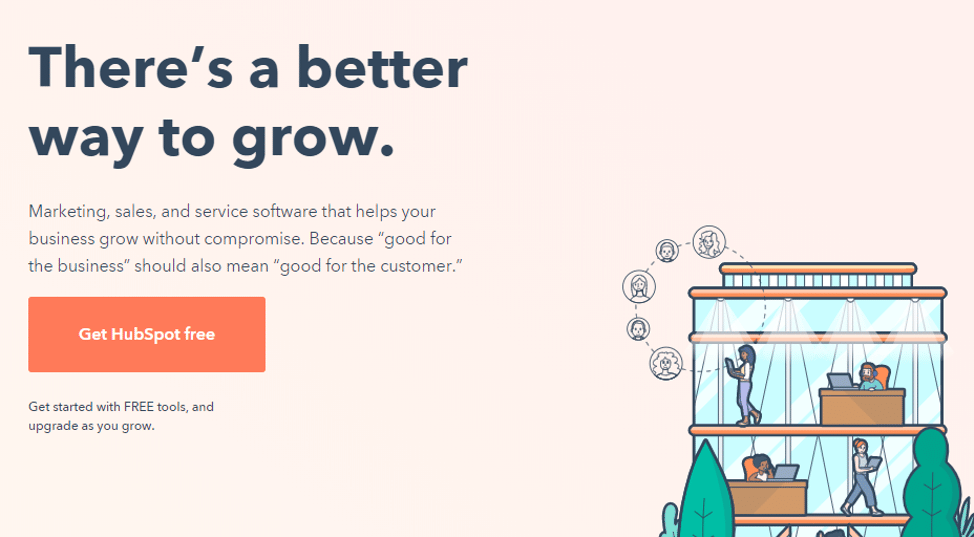
You already understand the basics of what you should look for in a marketing automation tool, so let’s skip right to business. In these next two sections, you’ll be introduced to two industry-favorite tools, and then we’ll break down what sets them apart.
Let’s start with HubSpot.
HubSpot is one of the biggest names in marketing, and they offer multiple types of services, including:
- Customer relationship management (CRM) software
- Marketing automation functionality (with a focus on content)
- Sales and lead-management tools
- A customer service hub
When you combine all that functionality, you get an all-in-one platform that can handle everything from contacts to sales, lead management, customer service, and marketing automation.
As far as marketing automation goes, HubSpot provides you with content creation functionality, as well as email and social media management tools. You also get access to in-depth analytics for every tool you use, which makes it easy to see how well your campaigns are performing.
Quick note: the HubSpot blog is one of the best online resources for marketing tips, so it’s recommended to bookmark it, even if you decide not to use their automation software.
An Introduction to Ontraport
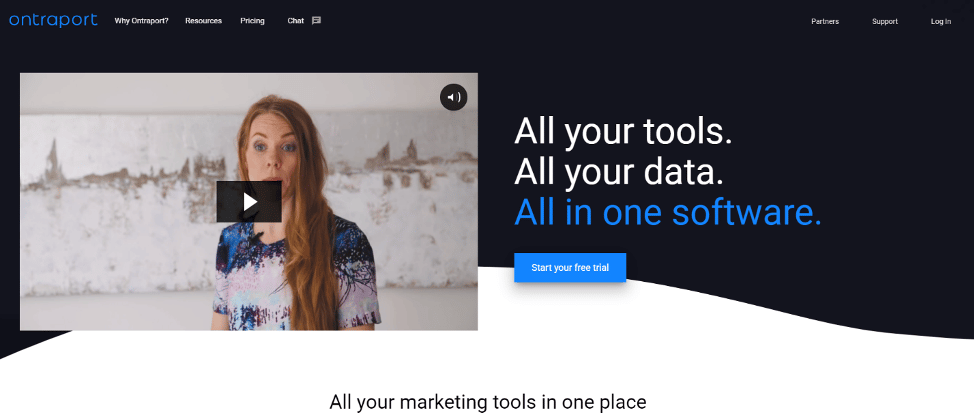
Ontraport is a top pick because, like HubSpot, they offer a lot more functionality than you’d expect from a marketing automation tool.
If you use Ontraport, you get access to a CRM system, email and landing page builders, SMS-marketing tools, and more. They even enable you to implement postcards within your marketing strategy.
Overall, Ontraport focuses on email marketing a lot more than HubSpot, which emphasizes content creation.
Beyond that, they also include shopping-cart tools, affiliate management functionality, webinar creation systems, and more.
That’s a very quick summary, though, so let’s dig down and compare the two platforms in several aspects, including features, ease of use, and pricing. That way, you’ll have all the data you need to make an informed decision.
HubSpot vs. Ontraport: Feature Comparison
When it comes to the sheer range of features, HubSpot has a clear lead over Ontraport. That’s because they provide a broader range of services. However, if you focus only on marketing, here’s what you get when you use HubSpot:
- Access to blogging tools that enable you to manage your content using an editorial calendar
- Tools to help you build and test landing pages
- Create, personalize, test, and send email marketing campaigns
- Manage your social media marketing, including monitoring your competitors, scheduling publications, and tracking engagement
- Design CTAs and measure their performance
- Track the performance of your ads across multiple platforms, including Facebook, Instagram, LinkedIn, and Google
- Integrate your marketing hub with third-party applications, which you can check out for yourself
There’s a lot of information to unpack there, but we’re here to talk about automation. HubSpot enables you to automate tasks that include all those features we just discussed, using what they call “workflows”:
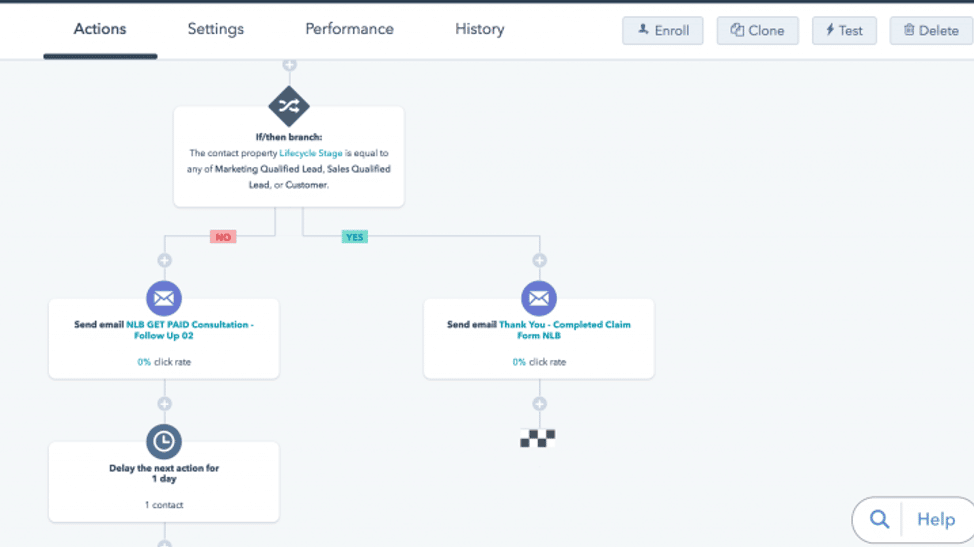
The way workflows work is that you set a goal and proceed from there, adding tasks the platform can handle for you on its own. In the screenshot above, you can see how HubSpot enables you to set lead scores for potential clients and then automate a follow-up email.
That’s just one example, though. HubSpot offers a broad library of pre-built workflows you can use to hit the ground running. Some quick examples include workflows for lead-nurturing campaigns, setting up webhooks, scoring leads, sending internal notifications to your team, and more.
Now let’s talk about Ontraport. Right off the bat, you’ll notice there’s a much bigger focus on email marketing with this platform.
Here’s what you get as an Ontraport user when it comes to marketing features:
- All the basics when it comes to email campaigns, including a visual builder, personalization functionality, split testing, and more
- Choose from a broad library of templates to kickstart your email campaigns
- Design and publish landing pages using a drag-and-drop builder and templates
- Score your leads and use that data to drive your outbound marketing efforts
- Manage your Facebook ads
- Create and share personalized URLs with your customers
As a quick aside, Ontraport also offers e-commerce functionality. That means you can use the platform to sell your services or products online and manage all your marketing campaigns, all with a single platform.
Moving on to automation — Ontraport enables you to design highly complex campaigns, including emails, SMS, and even postcards. Here’s a quick representation of what those automation processes can look like:
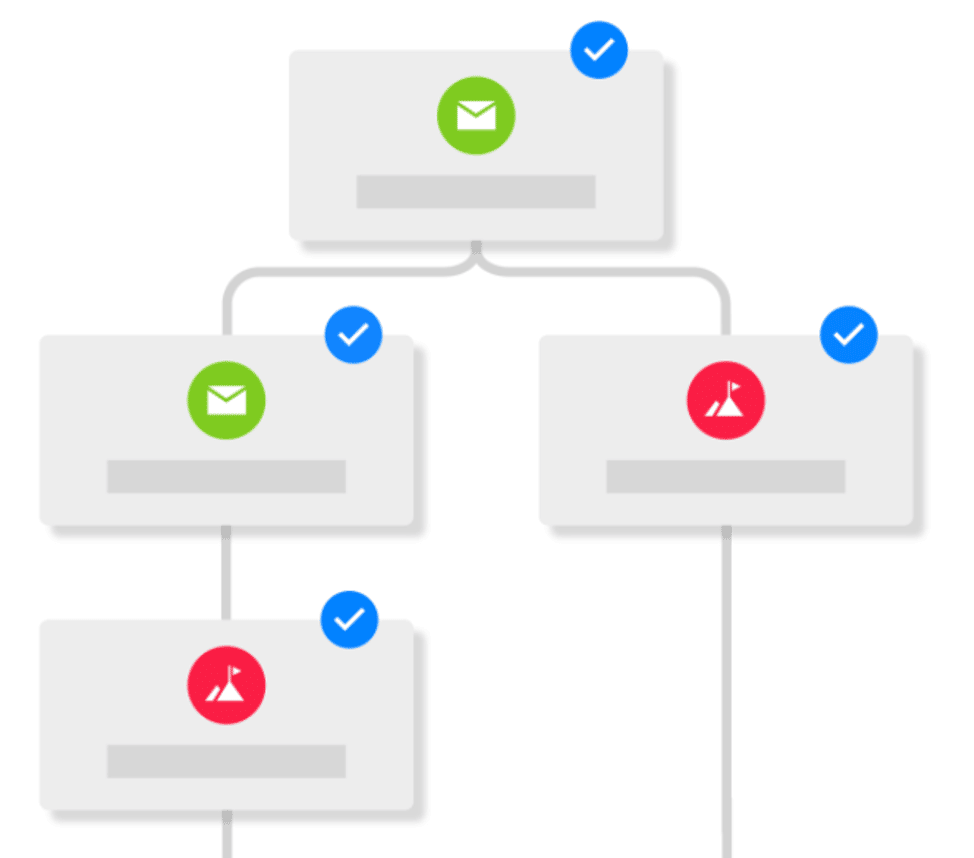
Automating your campaigns using Ontraport feels a lot simpler than with HubSpot, although you don’t get access to quite as many options. In essence, though, the two systems tackle marketing automation similarly. You set up triggers and configure actions that the platform will take for you based on what clients do.
For example, if someone signs up for your mailing list based on the promise of a free ebook, you can use Ontraport to automate its delivery. Ideally, that would be the start of a welcome campaign, which you can also design and schedule using Ontraport.
Like HubSpot, Ontraport provides you with data reporting. That means that you can track your campaign metrics, and when you combine that with split testing, it gives you a powerful set of tools to narrow down exactly what works for your audience.
The verdict: If you’re going to focus on email marketing, Ontraport is both easier to learn and cheaper (which we’ll go into in a moment). As far as email marketing automation goes, the two platforms offer most of the same features.
On the other hand, if you want to tackle content and email marketing using a single platform, HubSpot is the clear answer.
HubSpot vs. Ontraport: Ease of Use
If you’re a small business owner, you can’t spend weeks learning how to use a new platform. For as much time as marketing automation tools can save you, it’s also important that they offer a simple onboarding process.
HubSpot is in a bit of an odd position when it comes to ease of use. The learning curve is higher than with Ontraport because they offer a lot of tools beyond marketing automation.
As you might imagine, more expensive plans get access to a lot more features, which can make the onboarding process even longer.
The workflow tool itself is pretty easy to use, depending on what type of automation you want to implement. If you want to save time, you can use workflow templates as a starting point and modify them depending on your own marketing needs.
Finally, let’s talk about the user interface (UI). Although getting acquainted with all of HubSpot’s features will take you some time, the dashboard is pretty intuitive. As soon as you log in, you get an overview of your marketing campaign’s performance:

Likewise, navigating through all the tools at your disposal is pretty simple, even for a new user. Now let’s compare that with Ontraport.
At first glance, the Ontraport dashboard is much more streamlined. As soon as you access your account, you get a lot of metrics about your campaign performance:
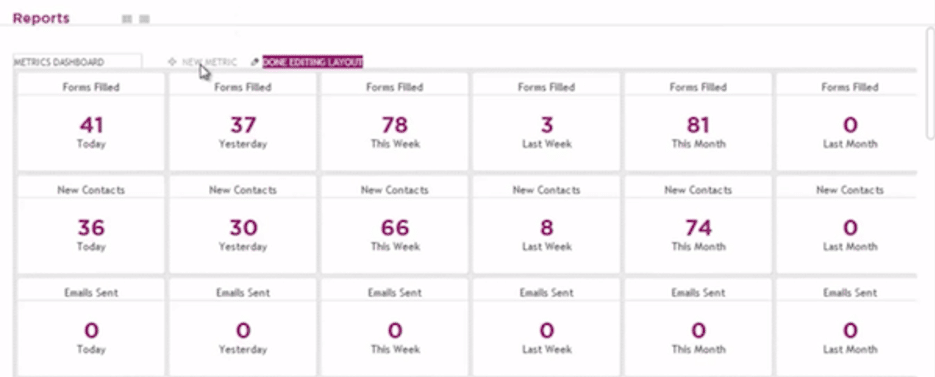
If you’re a numbers person, you’ll like the Ontraport approach. Plus, the platform enables you to customize the metrics you see on your dashboard, so you can prioritize whatever’s most important for you, such as open rates, number of new contacts, and more.
The learning curve here is noticeably simpler than HubSpot’s. Ontraport’s visual builders are easy to use even if you don’t have a background in email or landing page design. Likewise, automating campaigns is pretty simple even for a newbie.
It’s important to understand that although Ontraport can be easier to learn at first, all marketing automation tools have pretty steep learning curves. The more complex the automation you want to implement is, the more time you’ll have to spend learning the ins and outs of the platform you choose.
The verdict: Once more, if you’re planning to focus on email marketing, Ontraport is much simpler to learn at first. HubSpot, on the other hand, offers a lot more functionality, so the onboarding process can take more time for your team. Their collection of workflow templates is superb, though, which greatly simplifies the automation process.
HubSpot vs. Ontraport: Pricing
Let’s be upfront — most marketing automation tools don’t come cheap, and these two are no exception.
HubSpot, in particular, can get pretty expensive, as you can imagine, because of its extensive list of features. It all depends on which plan you choose:
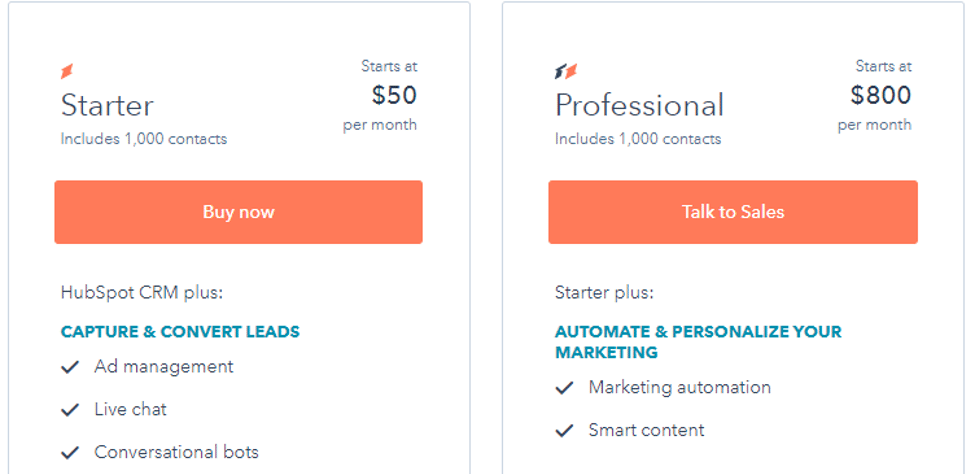
Although HubSpot offers a free plan, if you check out the feature list, you’ll notice that it doesn’t include marketing automation, which is what you’re after. Even so, it allows you to try the platform on for size and see if it feels like a good fit for you before committing to a paid plan.
I’m using the word “committing” because signing up for HubSpot is not cheap. New users have to pay an onboarding fee, which can range from $600-5,000 depending on the size of your business. Moreover, HubSpot doesn’t offer a month-by-month payment system. Instead, you pay annually, so there’s a high cost of entry.
If you’re trying to grow a small business, HubSpot can be a bit expensive. The “Starter” Marketing Hub plan will set you back $50 per month, but it doesn’t include automation. If you want access to workflows, you’ll have to pay at least $800 a month for the professional plan, which supports up to 1,000 contacts.
Running the numbers, that means paying an annual fee of $9600 plus onboarding costs. If you can afford that, though, HubSpot‘ more than delivers when it comes to functionality.
Now let’s take a look at Ontraport.
Right off the bat, I can tell you there’s a big gap in prices when you compare the two services. Ontraport has plans starting at $79 per month. For that, you can add up to 1,000 contacts to your dashboard and send an unlimited number of emails.
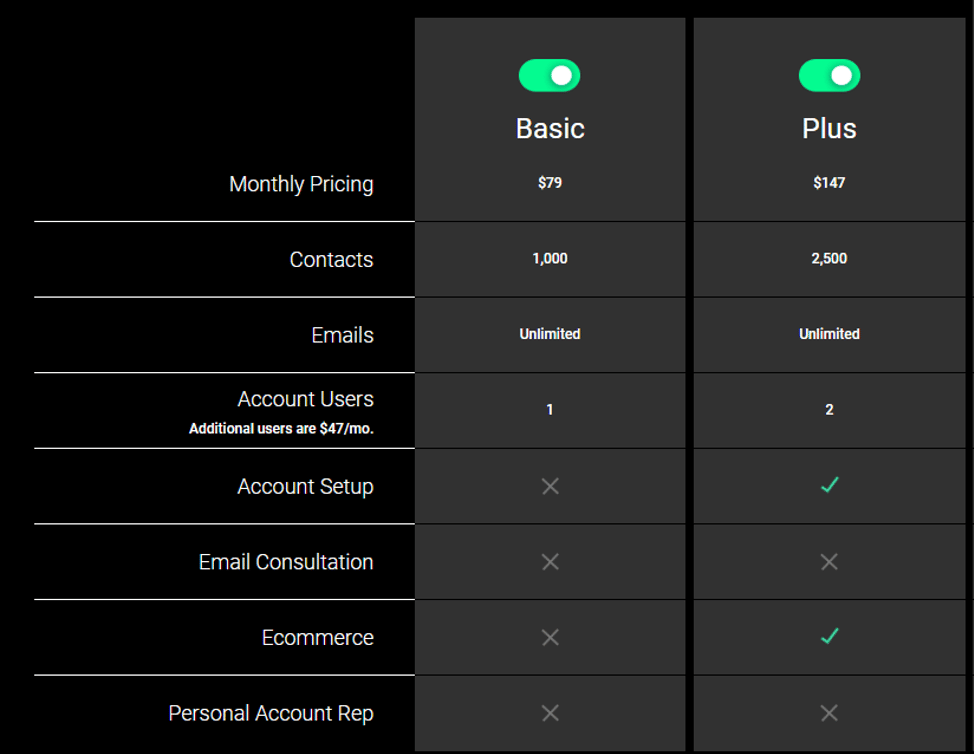
Compare that to HubSpot’s professional plan, which also supports 1,000 contacts, and there’s a gap of $731 per month. The upside with HubSpot is that the platform supports up to 25 unique teams, whereas Ontraport provides access to only one user with that basic plan.
Overall, Ontraport offers four different plans, with prices reaching up to $497 at the top of the scale for businesses that need to add over 20,000 customers to their contact list. That’s fantastic when it comes to bang for your buck, but it’s important to remember that you’re not paying for as many features as with HubSpot.
If you want access to the full suite of Ontraport’s marketing automation features, you’ll need to choose the Plus plan, which costs $147 a month. It supports up to 2,500 customers, and it offers all the same automation features as the more expensive plans.
Beyond the costs of the plans themselves, Ontraport doesn’t require you to pay a setup fee. They also offer a 14-day trial, so you can check out the service for yourself, get the hang of the platform, and see if it’s a good fit.
The verdict: Ontraport is the budget-friendly choice when it comes to marketing automation tools. However, the sheer range of features you get with HubSpot is impressive, which justifies the high price.
If you have a big team working with you, HubSpot is definitely the better option, despite its high price. For one-person operations and small businesses, Ontraport has the advantage.
Build a More Efficient Business More Efficiently Using Marketing Automation Tools
Marketing automation tools can be pretty expensive. However, it’s important to understand what you’re getting as part of the deal.
The entire point of automation is to save you time so you can focus on other aspects of your business. With marketing automation, you’re entrusting a platform with the systems that bring in new clients and money to your business.
That sounds a bit scary, but both HubSpot and Ontraport enable you to customize every aspect of the automation process. You choose what processes to automate and exactly how to do it. That usually requires a lot of upfront work, but the results should pay for themselves in the long run.
Disclosure: Please note that some of the links above are affiliate links. I only recommend products and services that I use and stand behind, and if you decide to try them, I will earn a commission at no cost to you. Doing so helps me run this blog and provide free content for you, my readers.






3 Responses